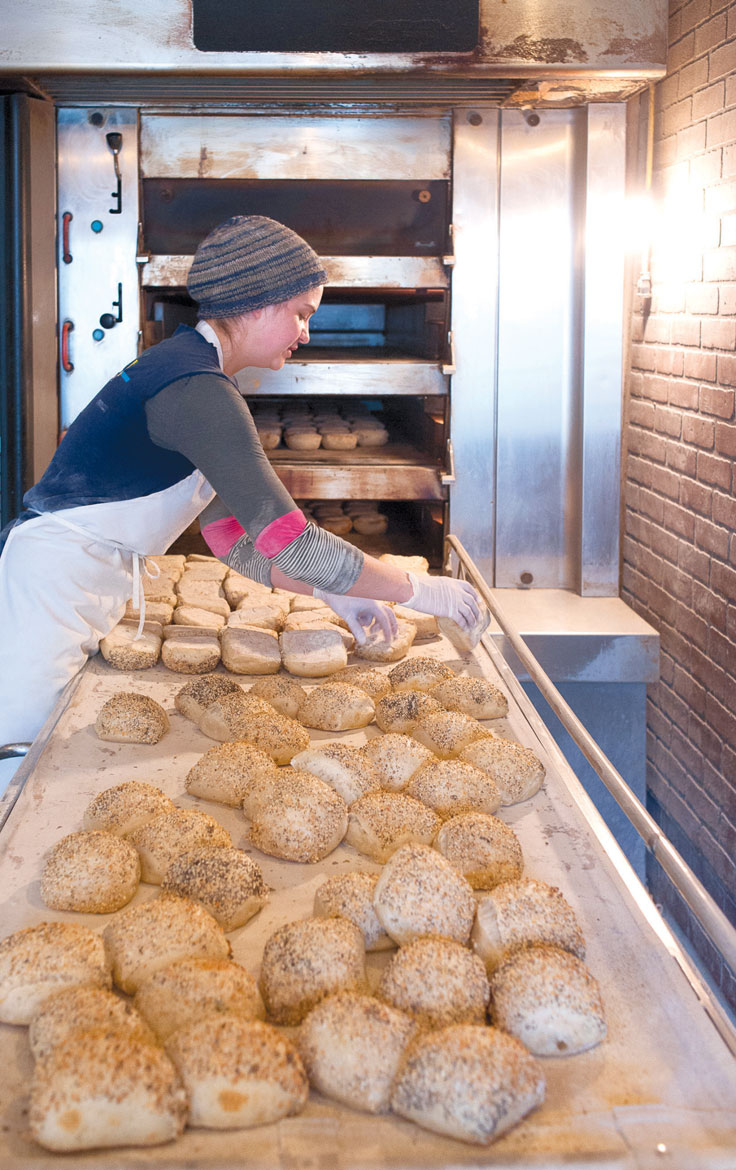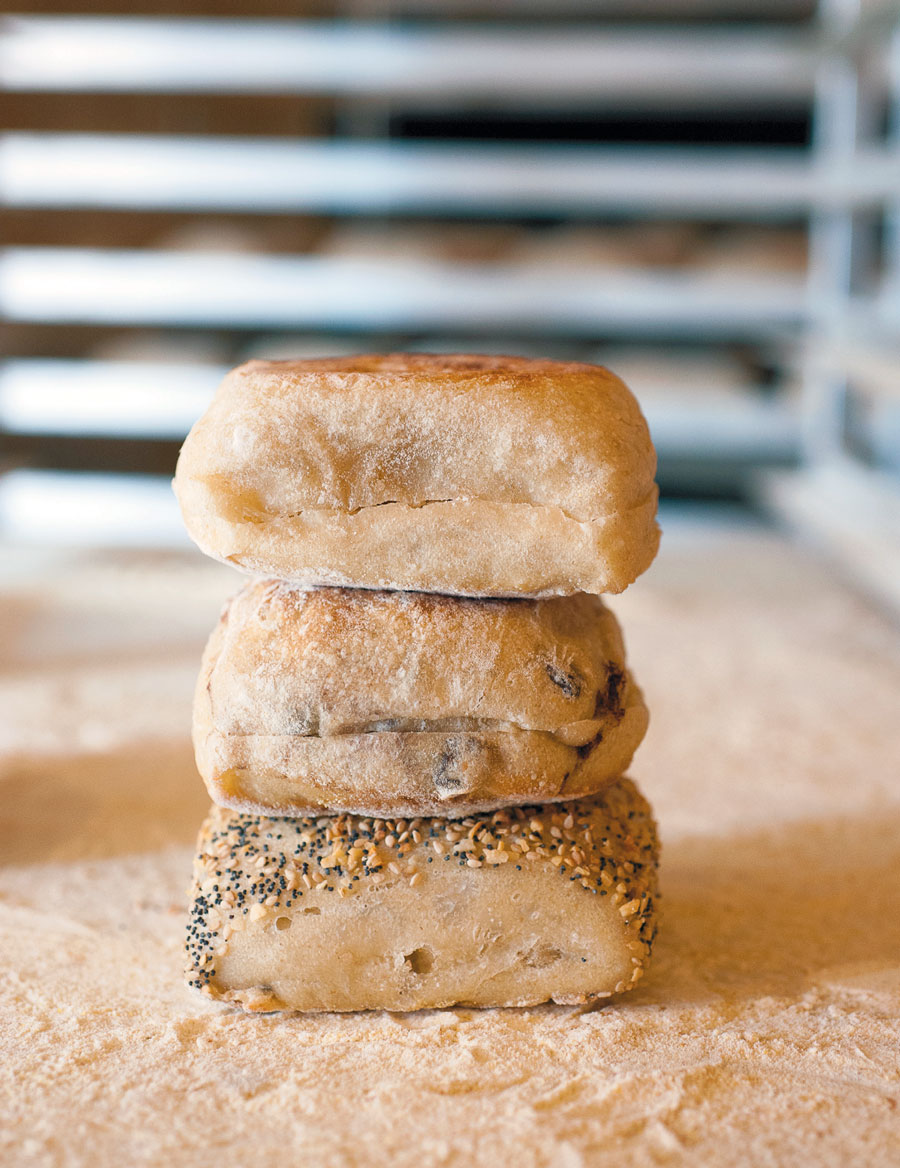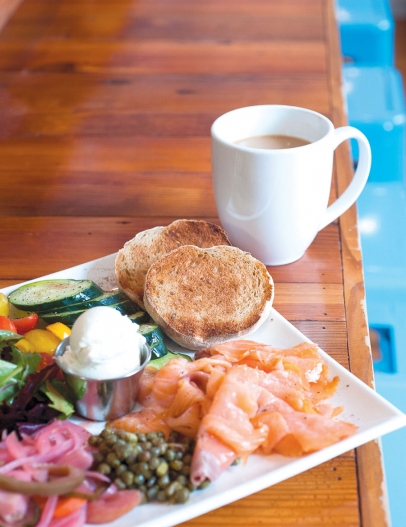Mighty Muffins
Local bakers put a Philly spin on a supermarket staple
If you’re like me, you grew up eating English muffins—Thomas, of course, in that white and orange box.
When I picture my parents’ kitchen, there’s that long cardboard box in a plastic bag, sitting next to the coffee machine. When I visit home and open their freezer, at least one spare bag—or the double-wide bulk pack from Costco—is there waiting, so that no morning need be without those crunchy nooks and crannies slathered in butter and jam.
On the first morning of my most recent trip home, I jumped at the chance to pop a Thomas’s in the toaster and taste nostalgia. But, as with most things, the real thing was inferior to the memory.
Thomas’s may be the standard, but compared to the artisan breads, whole-grain loaves, and flavorful sourdoughs baked all around Philadelphia, those prepacked muffins leave something to be desired. They’re soft and tender, yes, but the texture—untoasted, anyway—is unsubstantial. For someone like me, who could eat a breakfast every hour until noon, they’re rather puny and thin. As for flavor, you’d better be topping it with something exciting, because an industrial English muffin won’t provide much.
How did we get to this point? Thomas’s has monopolized the nookand- cranny market since its founder, Samuel Bath Thomas, invented the breakfast bread in the 1890s in New York.
The only English thing about the muffin is its creator, who came to the United States in 1874 from his home in Plymouth, England, and patented the innovation in 1894. His original name for it was the “toaster crumpet”—and the two do share some traits.
Unlike its descendant, the crumpet is leavened chemically, typically with baking soda. The English muffin gets its lift from yeast. Both are traditionally baked on a griddle (often in a metal ring to keep their shape) rather than in an oven, but the crumpet is only cooked on one side, forming its signature bubbly top (those same bubbles form the nooks and crannies inside an English muffin).
Finally, crumpets are eaten whole, not cut in half. The ideal way to split an English muffin, according to Thomas’s, is by pulling the two halves apart by hand or with a fork, never with a knife—which would destroy those bubbly nooks and crannies.
But enough about mass-produced muffins: there’s good news for those of us who crave a griddled breakfast bread with more character.
With the rise of the all-day cafe, diners’ desire for bespoke baked goods and the enduring popularity of brunch, chefs and bakers across Philadelphia are turning their attention not only to the baguette in your bread basket and the brioche bun sandwiching your burger, but also that craggy, crispy morning staple.

“The muffin was honestly
pretty accidental,” says Pete Merzbacher,
owner and founder at Philly Bread.
“I wish I could claim brilliance,
but I can’t.”
Rising to the Challenge
When Scott Schroeder and Pat O’Malley opened Hungry Pigeon, they knew a breakfast sandwich—an affordable, approachable staple— would be on the menu. They already had biscuits and gravy on the menu, so a straightforward, high-quality English muffin—made from part wheat and part white flour, with a hint of sourness and a chewy yet fluffy texture—was the goal.
“We were literally trying to make an Egg McMuffin,” says O’Malley, who spent eight years as pastry chef at New York’s Balthazar before opening Hungry Pigeon with Schroeder in 2016. “If you close your eyes and imagine [an English muffin], that’s what we wanted it to be.”
Like most people, O’Malley sees Thomas’s as the “gold standard”— but there’s always room for improvement. His process begins with a mixture of milk, white and locally milled wheat flour and prefermented yeast. This step gives the finished product a “bubbly, chewy gumminess and that lactic, milky, buttery quality” that O’Malley wants. An addition of sourdough starter and more yeast creates tangy flavor and boosts the rise. And rather than the farina that dusts the top and bottom of a Thomas’s muffin, he uses cornmeal to add flavor and prevent sticking during baking.
Hungry Pigeon’s muffins are griddled in clarified butter, which can handle the high heat of the flattop and adds yet more buttery flavor to the finished product. Compared to Thomas’s, they’re thicker, sturdier and much more buttery, with added flavor and body from the whole-grain flour in the mix. There are fewer nooks and crannies, but O’Malley’s muffins stand up to toasting well—the griddled surface crisps and the inside bookends a slice of pork roll, a fried egg, and some melted cheese much better than the flimsy mass-produced version.

Caitlin Orr, production manager at Philly Bread
Rye Not?
Less than a mile down 4th Street, in Pennsport, Joncarl Lachman and Lee Styer’s The Dutch offers another take on the English muffin at their Netherlands-meets-Amish-country spot.
On the menu at The Dutch, “Jonnathan’s rye English muffin” serves as the base for a riff on eggs Benedict as well as a smokedsalmon platter.
Its namesake is Jonnathan Yacashin, longtime sous chef at Noord and baker of breads for both restaurants, who developed the muffin at Styer and Lachman’s request.
“I think they’re coming back as a big breakfast kind of thing,” he says. “It seems like breakfast and brunch overall are becoming more popular.”
While Yacashin grew up eating pizza-fied Thomas’s English muffins—a kid-friendly meal if there ever was one—the version he makes for The Dutch is decidedly more complex.
The Dutch’s English muffins are based on Victorian milk bread, a soft, fine-crumbed loaf that toasts well. Yacashin swaps out milk and butter for a significant amount of heavy cream, which also adds richness. He uses rye flour and spikes the mixture with a little molasses, caraway seeds and both toasted and untoasted fennel seeds to add flavor and bring out the milk’s sweetness.
Another quirk of Jonnathan’s rye English muffin? Batches are first cooked on a dry griddle, then—in a departure from the traditional recipe—they’re finished in the oven. The result is a substantial yet airy muffin, tender and moist, with a flavor boost from that rye flour and rich heavy cream. It’s probably the most like a Thomas’s in terms of its softness and lightness, but still miles more substantial (and flavorful) than store-bought.
Standing Tall
Ellen Yin and Eli Kulp’s High Street on Market—another all-day cafe—is nationally renowned for its bread program, offering take home loaves, jewellike pastries and stellar sandwiches at breakfast and lunch. But their version of the English muffin is only available at High Street’s cousin, a.kitchen, as a side on the weekend brunch menu.
“I think most Americans are used to store-bought English muffins, which are dense and flat,” says head baker Ali Charnitski. “Our English muffins are actually quite tall and proud, thanks to our sourdough starter and method of production.”
She and her team leaven the muffins naturally with the same liquid sourdough starter that goes into all their breads. This high-hydration recipe (that’s baker jargon for a really wet, sticky dough) gets a few stretch-and-folds to help keep its structural integrity after an initial rise. To get a wide, airy crumb, Charnitski says, “we try to manipulate [the dough] as little as possible.” After portioning, shaping and proofing, the muffins are cooked on the flattop griddle in ring molds.
For Charnitski, English muffins present a fun alternative to the typical bun or bagel—plus, its unique traits make a meal extra special. “It’s out of the norm, which draws guests in,” she says, “and it’s easy to produce, which lends to the fluidity of our days in the bakery.”

Muffins from Philly Bread
Hip to Be Square
Of course, Philadelphia has a whole business that started by reclaiming and revitalizing this iconic baked good.
“The muffin was honestly pretty accidental,” says Pete Merzbacher, owner and founder at Philly Bread. “I wish I could claim brilliance, but I can’t.”
Merzbacher unknowingly started what would become a thriving wholesale bakery while experimenting with Tartine Bakery’s recipe for sourdough; he made focaccia, bagels, and other loaves. At one point, he fried some scrap dough in a pan with butter. He didn’t realize what he’d stumbled upon until he started bringing samples to potential customers, who overlooked his other breads but were interested in what he dubbed the “Philly muffin.”
Today, the Philly muffin is a puffy, outsized square with lots of flavor and chew; it’s available in white, heirloom wheat, cinnamon raisin and, in a truly genius move, “everything” spice. With the exception of the flavored varieties, it’s made with just four ingredients: flour, water, salt, and yeast.
While the original Philly muffin—made during off hours at a West Philly pizza spot—was griddled in fat, Merzbacher had to tweak the process. In order to meet production goals without adding 40 feet of griddle space to his Olney bakery, he developed a recipe with a cook time that lets him bake batches quickly, without sacrificing too much of the English muffin-inspired texture customers have come to love.
“The Philly muffin is still the cornerstone of our business,” Merzbacher notes. It’s the bakery’s top seller and the bread of choice at around 50 restaurants and cafes and more than a dozen independent retailers all over the city—and it’s in this item that Merzbacher sees the biggest potential for growth.
There are lots of other wholesale artisan bakeries in Philly making all kinds of breads—but Merzbacher is the only one making a version of the English muffin.
“If someone started making muffins, I’d feel competitive,” he says. “The Philly muffin is my baby.”
By all accounts, it’s a winner: with its substantial size, unique square shape, big flavor and toothsome chew—and, trademark be damned, nooks and crannies galore—love for the Philly Muffin extends beyond its home city. I brought some home to share with the family at Christmas a few years ago, and now, whenever I see my parents, they ask for a few bags to stash in the freezer alongside the Thomas’s.

Pat O’Malley at Hungry Pigeon
“We were literally trying to make an Egg McMuffin,” says Pat O’Malley, who spent eight years as pastry chef at New York’s Balthazar before opening Hungry Pigeon with Schroeder in 2016.
How Philly Eats Its English Muffins
At Hungry Pigeon, Pat O’Malley and Scott Schroeder serve a well-crafted take on the Egg McMuffin at their top-rated all-day spot in Queen Village. By all accounts, they’ve built the ur-breakfast sandwich, exquisite in its simplicity. Stick with the basic model— egg and jack cheese on O’Malley’s crispy-tender buttered English muffin—or add a slice of ham, a chicken sausage patty or a regional favorite, like scrapple or pork roll.
The Dutch does breakfast a little differently: its eggs Benedict comes with creamed chipped beef and sliced ring bologna straight from Berks County (just like owner Lee Styer), served on a foundation of Noord sous chef Jonnathan Yacashin’s milk-bread-inspired rye English muffin. If you want to try the muffin but like your morning fare a little lighter; order the smoked salmon platter, which also comes with cream cheese, capers, salad, and pickles.
Res Ipsa is best-known for chef Michael Vincent Ferreri’s deft way with fresh pastas at night, but this Center City all-day cafe’s daytime offerings are stellar too. He offers an Italian-inspired take on the classic breakfast sandwich: a slice of egg frittata and Asiago fresco are livened up with a spread made from herbs and long-hot peppers. Grab it and go or add bacon, fennel-cardamom breakfast sausage or spinach and a side order of ultra-crispy potatoes to treat yourself first thing in the morning.
At Fishtown’s cozy Sulima/s Restaurant, every thing spiced Philly muffins get stacked into sandwiches and draped in mornay sauce. But you’re in for a decadent treat when the strawberry cheesecake French toast— made with a base of original Philly muffins soaked in egg custard—is on special.
HungryPigeon
743South4thStreet
215.278.2736
hungrypigeonphilly.com
ResIpsa
2218WalnutStreet
267.519.0329
resipsaphilly.com
TheDutch
1527South4thStreet
215.755.5600
thedutchphilly.com
a.kitchen
135South18thStreet
215.825.7030
akitchenandbar.com
Sulimay’sRestaurant
632EastGirardAvenue
215.423.1773





